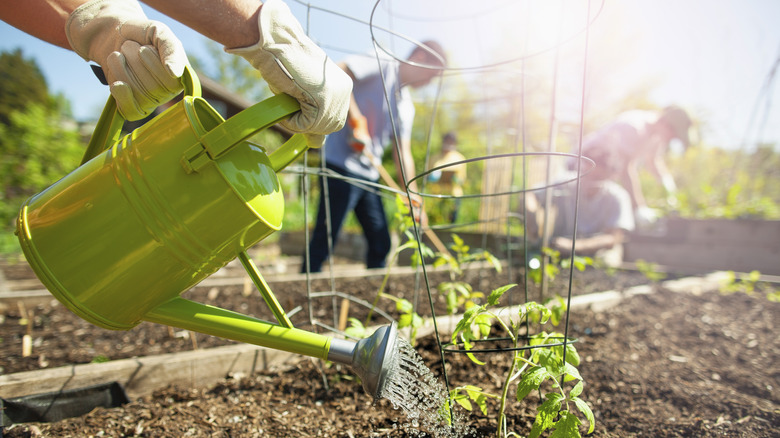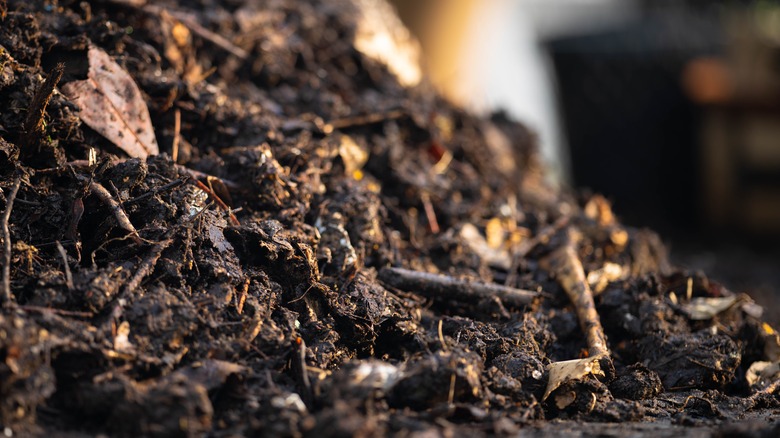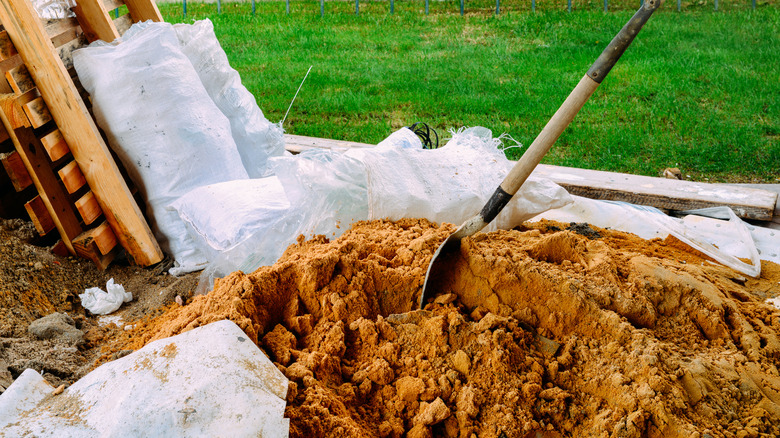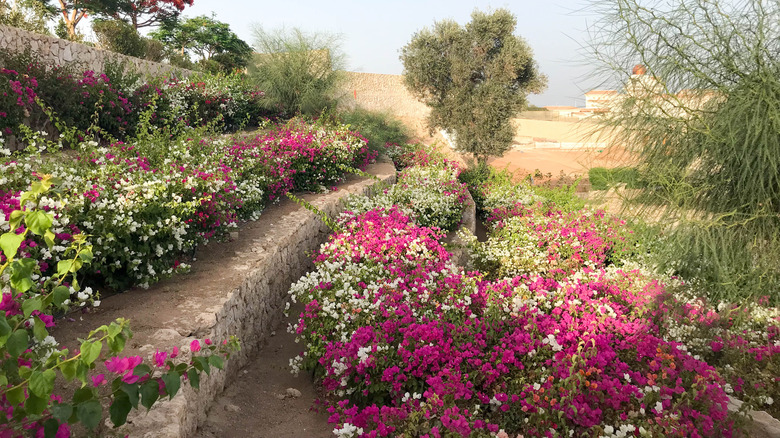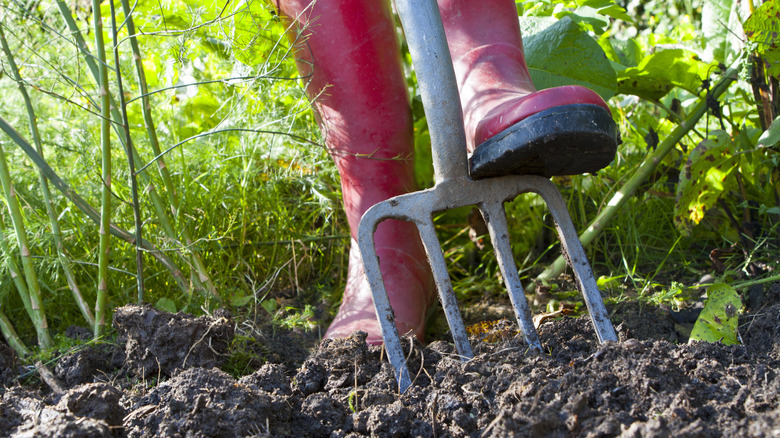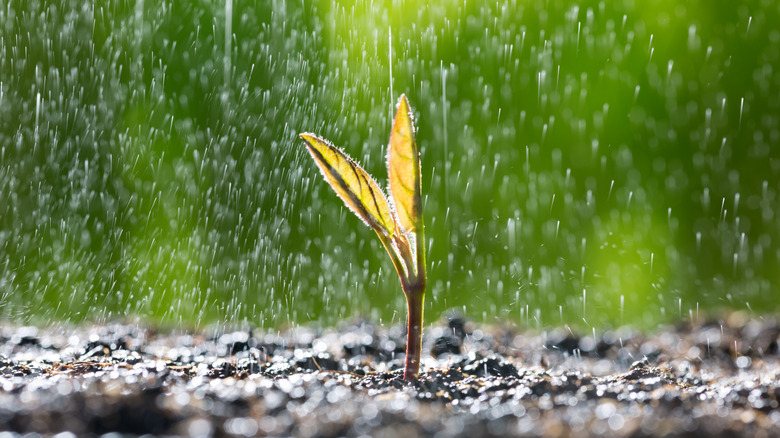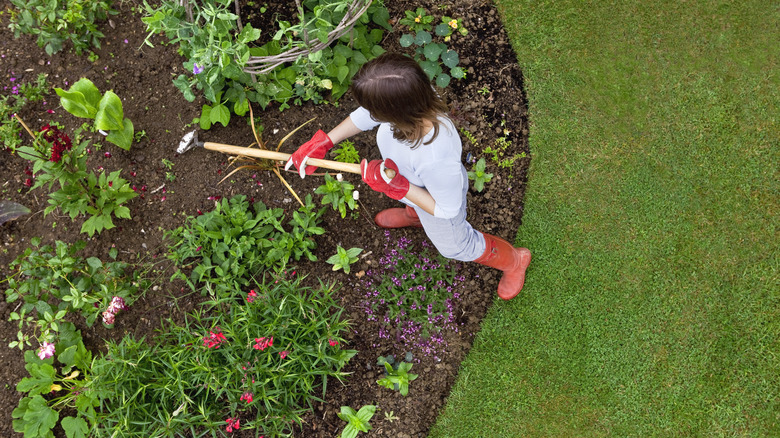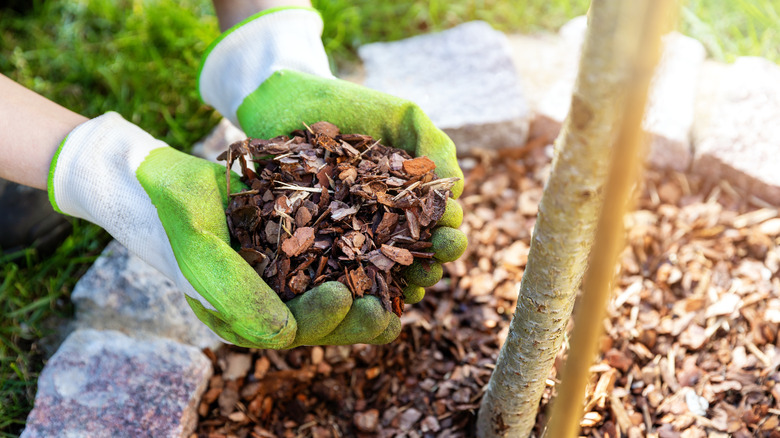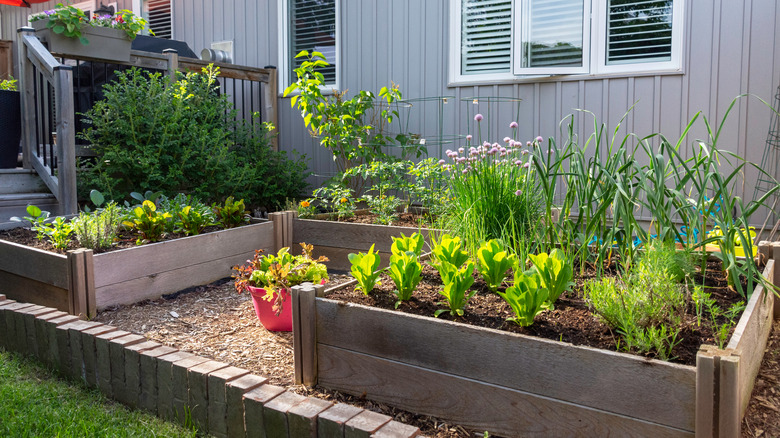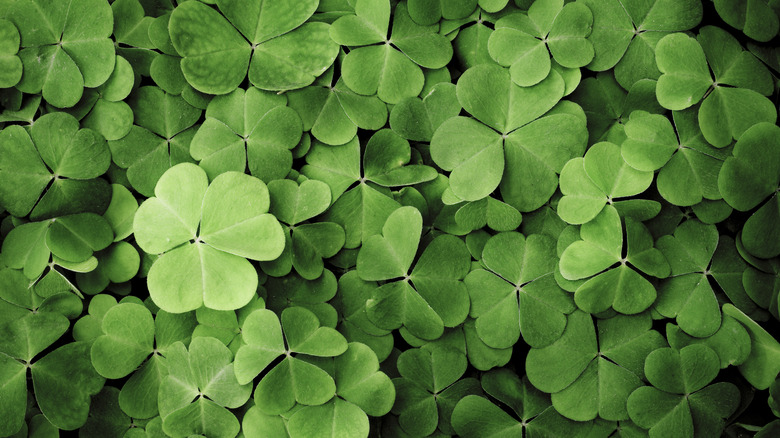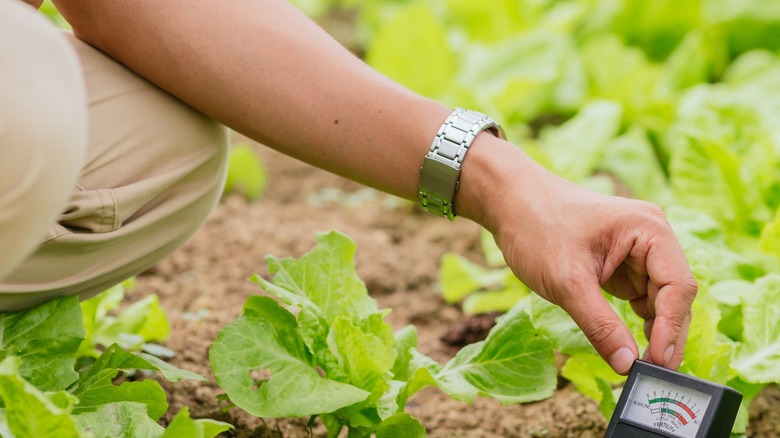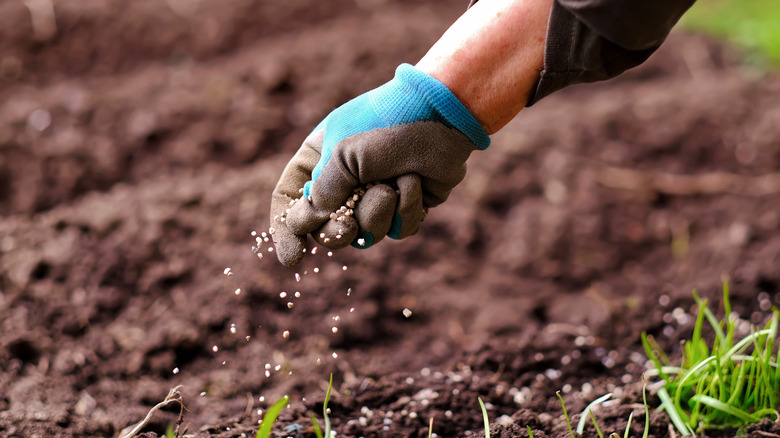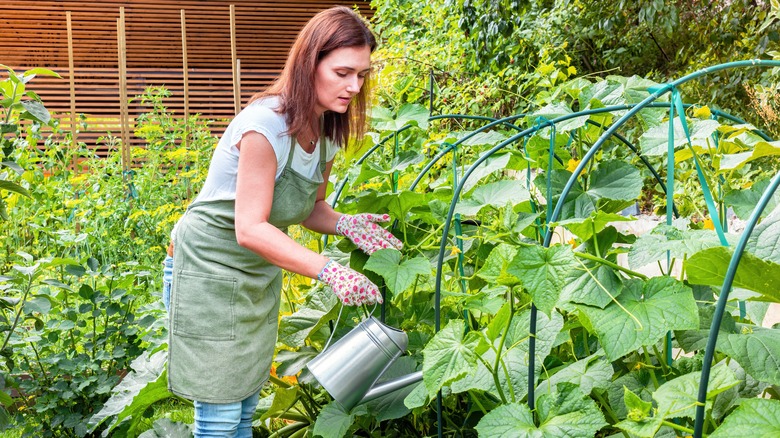The Ultimate Guide To Improving Heavy Clay Soil In Your Garden
Heavy clay is one of the most challenging soil types to work with. It can become waterlogged, anaerobic, super compacted, sticky when wet, and rock hard when dry. If you've already started trying to garden in clay, you'll know how back-breaking it can be to dig — and how few plants seem to thrive in clay-dominant soil.
Ready for some good news? With the correct amendments and handling, you can transform even the heaviest clay into rich, loamy soil that your plants will love. Clay soil may feel like a curse at first, but if you treat it right, it can become incredibly fertile. Thanks to its structure, clay houses high levels of nutrients and yields up minerals in response to plants' needs. It also retains water like no other medium — holding over 3x that of sand (via Clemson Cooperative Extension).
Whether you're looking to grow vegetables, create a stunning flower garden, or cultivate a verdant sea of green in your yard, you can achieve this in clay ground, provided you follow the right steps. If you don't, you may inadvertently make your soil even harder to work with. So, put your gardening gloves aside, shelve your shovel for a few minutes, and keep reading to learn how to optimize your clay soil.
Add lots of organic matter
Organic matter is the number one antidote to cumbersome clay and all the problems it poses to gardeners. Organic matter lightens clay soil, promoting better aeration, a springy structure, and more microbial life. No matter what type of earth you're working with, adding carbon via organic matter is always a good idea, and it's step one for creating a thriving garden. For clay, it can be a game-changer.
Organic matter is basically anything that decomposes and adds humus to your soil. Compost, animal manures, peat, lawn clippings, straw, wood chips, cardboard, leaf litter, and sawdust are all examples of carbon-rich materials that improve your soil. But before you bust out your fork, here are a few quick tips on incorporating these materials.
Compost is the king of soil amendments, and you can't really go wrong with how you add it. You can dig it in, mulch with it, or even plant directly in it. But if you're using compost to improve clay soil, be careful not to mix it in too aggressively. This may compact the clay and make your soil heavier instead of lighter. The same applies to straw, manure, and lawn clippings. If you're using wood chips or sawdust, it's best not to dig these in at all (instead, keep them on the top layer), as this can cause nitrogen deficiencies.
Don't add sand
In many ways, sandy soils are the opposite of clay. They're ultra-loose and light, don't hold onto water, and are pretty much devoid of aeration problems. If sand is the opposite of clay, adding some type of sand to your soil to lighten it makes sense, right? Wrong! Mixing sand into pure clay can actually make things a whole lot worse. Instead of lightening heavy clay, sand gives it a concrete-like consistency. Unless the only thing you're thinking of planting is poles for a pavilion, this is the last thing you want.
If there is very little organic matter present, any sand you incorporate will simply get bound up in the clay. However, you can consider incorporating sand once you've managed to improve your soil to the point where it's relatively light and will break apart when pressed into a ball. When you reach this stage, the best way to get sand into your beds is through your compost. By adding sand to your compost bin or leaf mold, you can ensure it gets coated with humus. This will help to stop the clay from grabbing onto it and getting even more dense.
Create swales and terraces to stall water
If you have a sloped garden, another way to improve clay soil long-term is to create terraces and swales on contour, the latter of which are essentially just shallow trenches built into the natural contour of the landscape. Clay soil is highly prone to waterlogging, so it might sound counterintuitive to create swales that stall and trap water. But creating swales isn't just about catching water — they also help to trap silt and organic matter that would have been washed away as the water travels down slope. Over time, this will build up, helping you create a layer of humus and loam over the clay.
The soil that's dug out of the trench to make a swale creates a mound. Besides stalling water, these mounds also act as raised beds. Because they're elevated, this improves drainage. If you don't want to have swales running through your garden, you can also try to level out areas and create terraces. "Stepping" your garden in this way helps to slow water runoff, retain sediment, and make your yard feel more landscaped.
Gently loosen the soil
If your clay soil is compacted (and there's a high chance it is) you can also physically loosen up the soil to help lighten it and allow in air. But be careful with this step, as full-on tilling may actually make clay more compacted. Don't till, turn, or dig your clay soil over too thoroughly. Instead, gently fork your soil to add aeration. You can also use a lawn coring aerator.
Too much tilling can be seriously bad news for clay ground, and it's also non-beneficial to other soil types, especially if done in excess. As agricultural researchers reveal the hazards of heavy tilling, many people are experimenting with no-till gardening methods (via Iowa State University). If you want to turn your garden into a no-till zone, all you have to do is add organic matter from the top without digging it in. By applying compost and mulch, you can build a rich layer of topsoil over the clay. Over time, roots, insects, earthworms, and water will help the two layers slowly mix.
Don't work wet clay
It can be tempting to head out with your garden shovel in hand after a good rain, but working wet clay is one of the worst things you can do. The more you manipulate saturated clay soil, the denser, more compacted, and less aerated it will become. You know how potters massage clay before throwing a pot? This process helps to ensure that the clay sticks evenly together and no cracks or air pockets develop. This is the exact opposite of what you want for your soil.
One of the reasons why clay is so sticky and dense is because its particles are incredibly tiny. Some are so small they can't be seen under a regular microscope and are up to 1,000 times smaller than course sand (via NYSDEC Environmental Education). Thanks to this, the particles easily "squish" together, leaving almost no air in between. The other downside to digging sodden clay ground is that the clods will stick to your implements, making the job a whole lot harder than it needs to be.
Tread lightly in your garden beds
You can compact clay by practically just looking at it. Walking on your garden beds is a surefire way to undo all of your hard work and stamp the air and looseness out of them. If you make a habit of walking around in your beds and borders, you might find that plants which were doing well start to struggle, and that the soil becomes tougher and tougher to work.
The best way to avoid this is by creating narrower beds which you can easily access from the sides. For larger planted areas, consider creating small paths or laying well-placed stepping stones. If you do have to step into a bed, try to tread lightly, and don't walk close to the base of plants if you can help it. Compacting the soil directly under plants inhibits root growth by squashing them. The less aeration there is in the soil, the more difficult it is for roots to take up water and nutrients, and the harder it is for soil microbes to thrive.
Mulch as much as you can
Mulching is a great strategy for improving clay soils as it adds biomass over time, encourages soil organisms, and helps stop the top layer of clay from drying out, hardening, and cracking. Covering your garden beds with a blanket of mulch can also discourage weed growth and conserve water. Wood and bark chips, manure, straw, and leaf mold are all great mulching materials.
The types of mulch you should use depends very much on your gardening goals and what you have available. Do you live close to a dairy farm where you can get cow manure? Or maybe you can easily get your hands on large quantities of straw? The best mulching materials are the ones you can access in bulk and that won't break the bank. This is especially true if you're trying to establish a vegetable garden where you need to add lots of organic matter to your soil every season. Manures, straw, and leaf mold are ideal for vegetable beds as they break down fast, quickly adding carbon to your soil. Cardboard is another quick-composting material to mulch with in a pinch.
If you're trying to improve beds for non-food-producing plants, you may want to opt for mulching material that is long-lasting and which you won't have to replace as frequently. Wood chips and bark chips are both great options. Bark chips can be more pricey, but they last even longer than wood chips if they're larger in size.
Build raised beds for better drainage
Improving clay soil is a slow process that can take time and patience. If you don't have either of these and really want some workable beds that plants will thrive in right away, raised beds are a good option. With a raised bed, you can create a thick layer of compost and loamy topsoil on top of your clay base. This is ideal for vegetable gardens and beds where you want to plant more finicky ornamentals that demand loose, loamy soil.
There are many ways to construct raised beds. You can build retaining walls out of bricks or planks nailed onto stakes, or build a bottomless wood box by joining four wide planks at their corners or stacking reclaimed lumber. If you have a lot of branches, try your hand at Hügelkultur, which are essentially raised garden beds made from rotten wood. For those with more money than time, you can also purchase raised bed frames.
Finally, it's even possible to create a raised bed with no sides by piling up soil and compost into mounds and leveling it out. There's nothing wrong with this method; the only issue is that the sides can be crumbly and sloped. Because of this, it may be harder to reach in and tend the bed without accidentally kneeling against and compacting the edges.
Look into cover crops
Cover crops can be a convenient way to improve larger areas over a couple of seasons. The right types of cover crop plants help break up clay soils through their roots. As the roots grow, this creates pathways through which air and water can penetrate. Once the cover crop dies, so do the roots, leaving their tunnels behind — as well as the decomposing plant matter, which adds minerals and humus to the soil. If you're working with a big garden, a small holding, or a totally blank slate, cover cropping could be a good option.
Clover, buckwheat, alfalfa, winter wheat, and fava beans are all great options for clay soils. Clover, fava beans, and alfalfa are nitrogen fixers. Both buckwheat and winter wheat have fine root systems that can create lots of tiny tunnels into your clay. Daikon radish is another cover crop to try. Their chunky roots tunnel deep down into compacted ground, breaking it up and creating large passages for air and water to penetrate.
Once your cover crop reaches maturity, cut it down before it seeds. For looser soil types, you can till the leaves and stems back into the soil. But for heavy clay, it's best to either fork it in gently or leave it to decompose on the surface.
Check your soil's pH
Clay soils are usually highly alkaline. Overly alkaline soils cause nutrient lock-out and result in plant deficiencies. Even though the right minerals might be present, the plants may not be able to take them up. The majority of nutrients available for plants to take up are within a pH range of 6.0-7.5. In soils with a pH of over 7.5, iron deficiencies can crop up. The availability of phosphorus begins to drop in highly alkaline soils, and plants may struggle to absorb trace elements like manganese, copper, and zinc.
To make sure your soil pH isn't a problem, you can test it. Buy pH test strips, a pH meter, or send soil samples in for lab testing. If you send your soil to a lab, you can get a full soil analysis done to measure nutrient levels. Dig out samples in multiple spots of your yard, from about 6 inches down. Remove any sticks or debris. If you're using pH strips, the first step is to add distilled water to each sample and create a sludge. Mix the soil and water together, and then pour it through a paper strainer into a glass or container. Insert your test strip into the water and consult the color-coded chart. If you're using a pH meter, all you have to do is insert the prong into your soil to take a reading.
Add amendments
If your soil is very alkaline, you can lower the pH by adding sulfur. Elemental sulfur is slow-acting and will take a few months to react with the soil and change the pH, but it's cheap and easy to apply. It's also beneficial for overall plant health, as it's an essential mineral. To apply, follow the directions on the packet and sprinkle it onto your soil, gently forking it in, or covering it with compost or mulch.
Gypsum is another amendment often recommended for clay soil, and it's long been believed that gypsum helps to lighten clay. Unfortunately, gypsum doesn't work overnight wonders on soil structure, but it can help improve your soil if it's sodic. How do you know if your soil is sodic? Sodic soil is characterized by very high pH levels, very dark or light coloration, and crusting. The best way to determine whether you're dealing with sodic soil is to have samples tested. You can then work out a treatment plan based on the readings.
Go easy on watering
Because clay holds onto moisture, it's very important that you don't overwater it. If you're excited about your new garden, it can be tempting to give it some love with the hose on a daily basis. But more is definitely not better when it comes to water and clay. Err on the side of underwatering, especially if you're used to working with loamy or sandy soil. If in doubt, stick a finger into the soil to see if it really needs water.
You can also gauge moisture levels in the ground by looking at your plants. If they're drooping, it's time to give them a drink. If they're standing proud, it might be better to pass. Take note: Drooping and wilted leaves are also signs of overwatering. If you're watering a lot and your plants are looking wilted, it's time to put down the sprayer.
Another tip when it comes to clay soils is to avoid watering heavily all at one go. If you oversaturate the soil, it can turn into sludge. The sheer weight of the excess water causes compaction, especially if you haven't added much organic matter yet.
